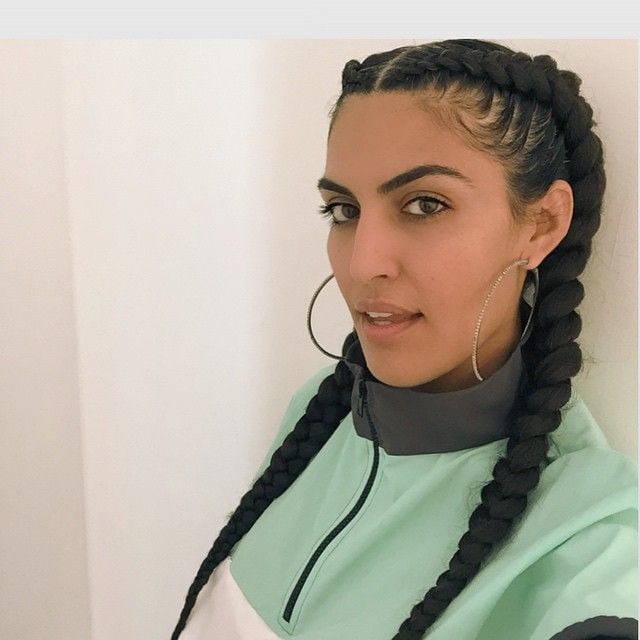 Melody Ehsani
Monte Cristo Teu
/
Artist
Melody Ehsani
Monte Cristo Teu
/
Artist
Celebrated across faiths and borderlines and spanning back over 3,000 years, Norooz (which translates from Farsi to “new day” and is commonly referred to as “Persian New Year”) coincides with the Spring Equinox on March 20th. In Iran, Norooz is a widely practiced public holiday — families often prepare with spring cleaning, and setting an alter-like table called the Haftsin, which is comprised of several items that reflect the values like renewal, health, and prosperity. The Baha’i faith observes Norooz as a holy day, and leads up to it with a 19-day fast. It’s a time for us to reflect, be with family, and remember our cultural roots.
When iconic Fairfax Avenue retailer Melody Ehsani abandoned law school to pursue her calling, she realized that design was a part of her “divine blueprint.” Known for her bold and colorful sneaker collabs with brands like Reebok and custom statement jewelry, her business is dedicated to empowering women to be their true selves: “I want the women who wear my pieces to have the same opportunity for equality, wholeness, and self expression,” she says. Attributing much of this to her Baha’i faith and Iranian background, Ehsani will be one of the millions of her diaspora celebrating Norooz.
As children of Iranian immigrants, folks like Ehsani and I have learned these traditions from our parents, who’ve carried these practices with them to their homes away from home. “We’ll have dinner, hang out, and turn the TV to the Persian channel to watch the Norooz countdown, and tune in to the rest of the Iranian world.” Ehsani said. “My family always reiterates how big of a deal this time of year is in Iran, and how they’ve lost a part of that by coming to America.”
Self-identifying and proudly displaying our heritage as Iranian Americans has always been complicated — and this is even more pronounced in a climate of policies and political rhetoric that are anti-immigrant, anti-refugee, and anti-Muslim. Ehsani reflected on how that’s impacted her family, and strengthened the importance of preserving and sharing her family’s Iranian and Baha’i practices: “[It] humanizes us when we’ve been really marginalized in so many ways, because people don’t know what to expect when you tell them you’re Iranian.”
Ehsani told The FADER how her family celebrates Norooz, how her culture influenced her vision as a designer, and the importance of preserving tradition.
Melody Ehsani: Growing up in an Iranian Baha’i family, there’s always something really special about this time of year. My mom is super anal about how her haftsin is set up, and it’s always really important to have something new to wear. It’s very much “out with the old, in with the new,” — we always get rid of everything that didn’t serve us the year before. My mother always expresses her wishes for us, and there’s a side of her that is superstitious — she will burn esfand, which gets rid of a bad omen. We fast for 19 days and then celebrate the New Year’s Day, waking up before the sun rises, and sleeping super early to repeat it over again. It’s a very spiritual time, as we prepare our souls for the beginning of a new year.
As I’ve grown older, I have begun to identify more and more with these spiritual practices — I get up in the morning and pray or meditate, and work on specific things within myself. Whether it’s having a stronger awareness of who I am or having my intuition become more keen, so that I can make better decisions. I think a lot of those superstitious things became stronger for me, because I’ve learned how these beliefs bring community together. I see the nostalgic quality it has for my family. I love that they get that sort of feeling and memory at this time, and I recognize how I don’t identify with it in the same way. My family always reiterates how big of a deal this time of year is in Iran, and how they’ve lost a part of that by coming to America. It’s not the same for them.
 Melody Ehsani
Artist
Melody Ehsani
Artist
I’ve also questioned our culture as I began to see it for what it was — I’ve been taught that if you want to be respected, and noble, and want to contribute to society, you have to do science, or law, or medicine, or something along those lines. But I learned and realized that there’s nobility in everyone’s art and purpose, that art indeed has nobility, and my whole mind shifted. Our culture is so incredibly rich, and I’ve been able to extract some of the beautiful aspects of it, like the art. Iranians were the first people to create indoor gardens, for example. Researching things like that has really affected my aesthetic and my work. I’ve realized the most important thing I could do on this planet is to live out my design, or whatever I felt like I really loved and had to contribute to the world.
It’s important now, more than ever, for Iranians to practice, talk about, and share our traditions. Tradition tells you so much about where someone came from, what they went through, how they got here. It shows we have this ancient rooted history, these beautiful traditions and customs, and this is what the meaning is. That really humanizes us when we’ve been really marginalized in so many ways, because people don’t know what to expect when you tell them you’re Iranian. It’s really important to share these things and show them what we’re about.